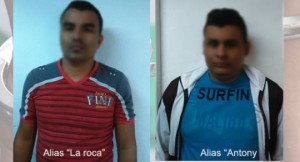
EspañolOn Friday, February 20, Colombian police captured 17 alleged members of Colombia’s largest and most highly organized paramilitary organization, aside from Marxist guerrilla group FARC. Those detained from among the criminal Úsuga band, also known as Los Urabeños, from near the Venezuelan border in Cúcuta include regional boss La Roca and his right-hand man “Antony.”
Beginning as a rank-and-file member, La Roca rose to the top of the Úsuga band in the Norte de Santander region. He directed the shipment of narcotics, other smuggling operations, and led a group of hitmen to settle scores with rivals.
Antony is accused of taking part in at least eight murders over the last five months in Norte de Santander, according to Colombian security forces.

The other 15 suspects are under investigation for alleged ties to the criminal band.
Los Urabeños is considered to be the most dangerous paramilitary organization in Colombia engaged in the country’s decades-old armed conflict. It has a vast presence nationwide and is responsible for considerable part of Colombia’s domestic and international drug trafficking.
The Dismantling of Los Urabeños
Since the beginning of 2015, several important Úsuga leaders have been arrested. On January 9, the Colombian army announced the capture of the band’s number four, Abeja, an active member of the group for 14 years. With his arrest, Los Urabeños lost a key leader with experience and connections in the underground world of the César and Norte de Santander regions, where he allegedly also carried out several murders in San Alberto and La Esperanza.
On the same day, the police apprehended Franco Jiménez (AKA Omar) one of the band’s leaders in Medellín who supervised trafficking in the Chocó and Norte del Valle regions. Omar was the second in command of the clan’s Pacific subdivision and helped secure alliances and ties with other criminal groups in Medellín, Córdoba, and Urabá.
Then, on February 19, the army arrested Miguel Ángel Alfaro, one of the most important links between the Úsuga clan and Mexican cartels the Sinaloa and Los Zetas.
A US court has requested the extradition of Alfaro, known within the criminal band as El Flaco, to respond to drug-trafficking charges. Authorities believe he handled the shipping and distribution of cocaine from the Valle and Cauca regions to the United States and Central America.
Ten days later, Colombia’s anti-narcotics police division intercepted a 500-kilogram cocaine shipment belonging to Los Urabeños. The drug, produced in clandestine labs from the Eastern Plains, was being transported to Cartagena, bound for Central America. This represented a major blow for the gang’s finances, as the cargo represented some 1.2 million doses of cocaine with an estimated street value of US$6.3 million.
Another blow came on February 5, when police arrested 13 members, among them the girlfriend of Darío Antonio Úsuga, the clan’s leader, and Hárlinson Úsuga Úsuga (AKA Orejas). They were able to extract valuable information about smuggling routes overseas and how the band supplemented its income through various state contracts via third parties.
But the most significant arrest happened on February 18. Colombian authorities captured the band’s mastermind and right-hand man, Abimel Coneo Martínez (AKA Torta). According to local daily El Espectador, he traveled to the capital, Bogotá, seeking to get the Úsuga clan included in the peace talks the administration of President Juan Manuel Santos is currently holding with the FARC guerrilla in Havana.
El Espectador released a video of Torta’s arrest:
In the wake of the latest arrests, Colombia’s ombudsman revealed that the criminal bands that arose after the disarmament of paramilitary groups since 2003 still operate in 27 out of Colombia’s 32 regions.
Translated by Daniel Duarte. Edited by Fergus Hodgson.
 Versión Español
Versión Español












